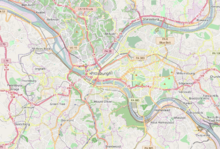Pittsburgh Center for the Arts
| Established | 1945 |
|---|---|
| Location | Pittsburgh |
| Coordinates | 40°27′09″N 79°55′12″W / 40.452406°N 79.920133°W |
| Website | http://center.pfpca.org/ |
| Designated | 1971 |
The Pittsburgh Center for the Arts (PCA) is a non-profit community arts campus that offers arts education programs and contemporary art exhibitions in Pittsburgh, Pennsylvania, United States.
It also provides services and resources for artists throughout Western Pennsylvania. PCA provides a venue for the community to create, see, support, and learn about visual arts. Founded in 1945, PCA is located at 6300 Fifth Avenue in the Shadyside neighborhood. Though, according to the City of Pittsburgh Map, the center is located in the Point Breeze neighborhood.
Famed artist Keith Haring had his first one-man exhibition at the Pittsburgh Center for the Arts in 1978 before moving to New York City and becoming one of the most prolific artists of the late 20th century.
The PCA's opened on March 17, 1945, as the "Arts and Craft Center" at Fifth and Shady Avenues. Almost 1000 Pittsburghers gathered at the opening night ceremonies, headed by Mayor Cornelius D. Scully, J. Bailey Ellis, who was named chairman of the Center, and Mrs. Charles D. Marshall, who publicly turned the key to her home over to the city.
Ten artist groups comprised the center at its founding:
The first program after the grand opening was a musicale given by the Musician’s Club on March 25, 1945. Each of the ten groups were responsible for holding five programs open to the public each year. The first Christmas Bazaar was held in November 1946, and continues today as the Holiday Sale.
The organization was chartered in July 1947. The first annual meeting to which all members of the various artist groups were invited was held on January 12, 1948. The newly revised by-laws were read and accepted. The elected board and officers were unpaid.
The center’s dedication to improving the overall quality of life in Pittsburgh through education has been an essential part of its philosophy from the beginning. The first mention of classes appeared in the minutes of the June 1947 board meeting. University of Pittsburgh professor Walter Hovey, then president of the Pennsylvania Guild of Craftsmen, asked for the use of the kitchen in order to hold a jewelry class for some 40 students.
...
Wikipedia

